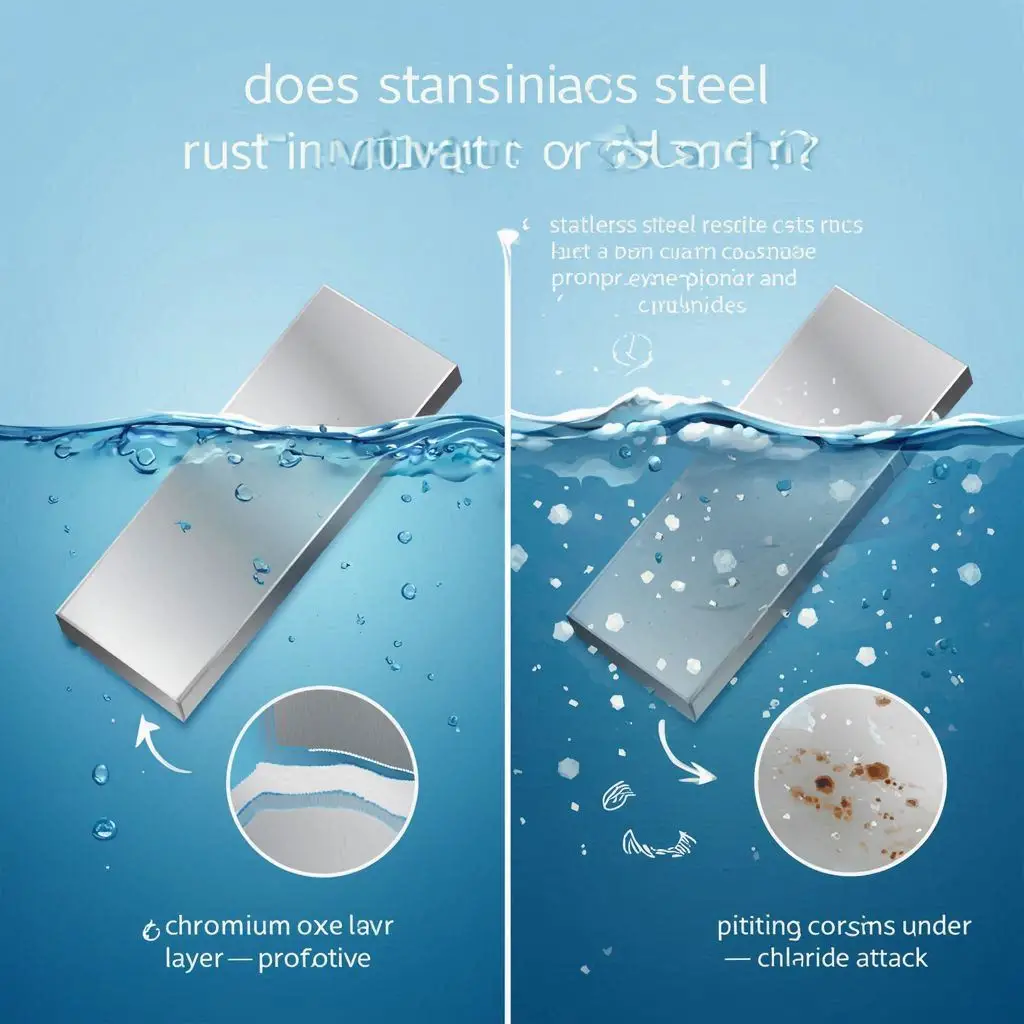
Does Stainless Steel Rust in Water or Salt Water?
Does Stainless Steel Rust? Water and Saltwater Corrosion Explained
Stainless steel resists rust, but under certain conditions like prolonged water or saltwater exposure, corrosion can still occur. Learn how and why stainless steel can rust in different environments.
INTRODUCTION
Stainless steel is widely known for its corrosion resistance, but many ask, does stainless steel rust in water and salt water? The answer depends on environmental conditions, alloy type, and exposure levels.
SEO Summary:
This guide explains whether stainless steel rusts in water and saltwater, covering causes, types of stainless steel, and prevention methods.
DOES STAINLESS STEEL RUST IN WATER?
While stainless steel is resistant, it can rust in water under certain conditions such as poor alloy composition or stagnant environments.
SEO Summary:
Stainless steel may rust in water due to low chromium content or lack of oxygen which prevents passive film regeneration.
Why Stainless Steel Is Rust-Resistant but Not Rust-Proof
Stainless steel contains at least 10.5% chromium, forming a thin, passive oxide layer that protects it from oxidation. This film prevents water molecules from reaching the iron beneath. However, in low-oxygen, high-acidity, or high-chloride conditions, this film can break down.
How Water Conditions Affect Stainless Steel
- Fresh flowing water: Rarely causes rust unless the alloy is of low grade.
- Stagnant water: Low oxygen levels impede oxide film repair, leading to corrosion.
- High temperature water: Accelerates chemical reactions, increasing rust risk.
Best Stainless Steel Grades for Water Exposure
- 304 Stainless Steel: Common, moderately corrosion-resistant.
- 316 Stainless Steel: Contains molybdenum, more resistant to water corrosion.
- 430 Stainless Steel: Cheaper but more prone to rust in water.
External Sources:
- https://www.azom.com/article.aspx?ArticleID=1447 (rel="nofollow", target="_blank")
- https://www.corrosionpedia.com/definition/2663/passivation (rel="nofollow", target="_blank")
DOES STAINLESS STEEL RUST IN SALT WATER?
Saltwater significantly increases the risk of rust in stainless steel due to its high chloride content.
SEO Summary:
Stainless steel is much more likely to rust in salt water because chloride ions aggressively attack the passive oxide layer.
Why Salt Water Is More Corrosive
Saltwater is rich in chloride ions, which break down the protective chromium oxide layer faster than in fresh water. Once this passive layer is compromised, the underlying iron reacts with oxygen and moisture, forming rust.
Types of Corrosion in Saltwater Environments
- Pitting Corrosion: Localized rust spots forming holes.
- Crevice Corrosion: Occurs in gaps or shielded areas like joints.
- Stress Corrosion Cracking: Affects welded or stressed components.
Stainless Steel Alloys Suited for Saltwater
- 316L Stainless Steel: Low carbon version of 316, excellent for marine use.
- Duplex Stainless Steel: Higher strength and chloride resistance.
Protective Measures in Saltwater Use
- Use marine-grade alloys (316L or higher).
- Apply protective coatings.
- Perform regular freshwater rinses after saltwater exposure.
External Sources:
- https://www.marlinwire.com/blog/can-stainless-steel-rust (rel="nofollow", target="_blank")
- https://www.bssa.org.uk/sectors.php?id=24(rel="nofollow", target="_blank")
STAINLESS STEEL RUST TYPES AND CAUSES
Different types of rust affect stainless steel depending on the exposure and environment.
SEO Summary:
Understand pitting, crevice, and galvanic corrosion to choose the right stainless steel and avoid failure.
Main Corrosion Forms on Stainless Steel
- Pitting Corrosion: Small pits caused by chloride ions.
- Crevice Corrosion: Happens in confined spaces like washers and joints.
- Galvanic Corrosion: Occurs when stainless steel contacts a dissimilar metal in an electrolyte like seawater.
Contributing Factors
- Chlorides: Destroy the passive layer.
- Mechanical stress: Enhances crack formation.
- Improper cleaning: Iron particles from tools can trigger rust.
External Sources:
- https://www.totalmateria.com/page.aspx?ID=CheckArticle&site=kts&NM=323(rel="nofollow", target="_blank")
HOW TO PREVENT STAINLESS STEEL FROM RUSTING
Proper maintenance, cleaning, and alloy selection significantly reduce rust risk.
SEO Summary:
Prevent stainless steel rusting through material choice, design, and protective maintenance routines.
Key Prevention Strategies
- Select the right alloy: Use 316/316L for marine or chloride-heavy environments.
- Avoid dissimilar metal contact: Prevent galvanic corrosion.
- Rinse regularly: Especially after exposure to salt or harsh chemicals.
- Use passivation: Chemical treatment that enhances chromium oxide formation.
- Apply coatings: Epoxy, paint, or corrosion inhibitors.
Design Tips
- Avoid crevices in design.
- Ensure water drainage.
- Polish surfaces to prevent dirt accumulation.
External Sources:
- https://www.bssa.org.uk/topics.php?article=117 (rel="nofollow", target="_blank")
- https://www.nace.org/resources/general-resources/corrosion-basics(rel="nofollow", target="_blank")
FAQ: COMMON QUESTIONS ABOUT STAINLESS STEEL RUST
Q1: Will stainless steel rust if scratched?
Yes. Scratches can remove the passive layer, exposing the steel underneath, especially in harsh environments.
Q2: Can vinegar or bleach cause stainless steel to rust?
Yes. Bleach and even vinegar can be corrosive, especially with prolonged exposure.
Q3: How long does stainless steel last in salt water?
It varies by grade. 316L can last many years with proper care, but lower grades may corrode within months.
Q4: Is stainless steel good for marine applications?
Only specific grades like 316L or duplex stainless steel are suitable for continuous saltwater exposure.
CONCLUSION
While stainless steel resists corrosion, it is not entirely rust-proof—especially in water or saltwater environments. Choosing the right grade, maintaining the material, and understanding environmental exposure are critical in preventing rust. For marine or chloride-heavy applications, always opt for high-grade options like 316L.
SEO Summary:
Stainless steel can rust in water and saltwater, but with the right material choice and care, rust can be minimized or prevented entirely.
📌 For sourcing high-quality, rust-resistant steel and oil-based corrosion inhibitors, visit www.novintrades.com

